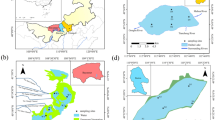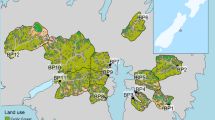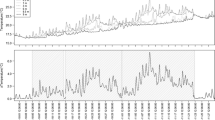Abstract
Cycling of phosphorus (P) at the sediment/water interface is generally considered to be an abiotic process. Sediment bacteria are assumed to play only an indirect role by accelerating the transfer of electron from electron donors to electron acceptors, thus providing the necessary conditions for redox-and pH-dependent, abiotic sorption/desorption or precipitation/dissolution reactions.
Results summarized in this review suggest that
-
(1)
in eutrophic lakes, sediment bacteria contain as much P as settles with organic detritus during one year
-
(2)
in oligotrophic lakes, P incorporated in benthic bacterial biomass may exceed the yearly deposition of bioavailable P several times
-
(3)
storage and release of P by sediment bacteria are redox-dependent processes
-
(4)
an appreciable amount of P buried in the sediment is associated with the organic fraction
-
(5)
sediment bacteria not only regenerate PO4, they also contribute to the production of refractory, organic P compounds, and
-
(6)
in oligotrophic lakes, a larger fraction of the P settled with organic detritus is converted to refractory organic compounds by benthic microorganisms than in eutrophic lakes.
From this we conclude that benthic bacteria do more than just mineralize organic P compounds. Especially in oligotrophic lakes, they also may regulate the flux of P across the sediment/water interface and contribute to its terminal burial by the production of refractory organic P compounds.
Similar content being viewed by others
References
Barsdate, R. J., T. Fenchel & R. T. Prentki, 1974. Phosphorus cycle of model ecosystems: Significance for decomposer food chains and effect of bacterial grazers. Oikos 25: 239–251.
Borsheim, K. Y., G. Bratbak & M. Heldal, 1990. Enumeration and biomass estimation of planktonic bacteria and viruses by transmission electron microscopy. Appl. envir. Microbiol. 56: 352–356.
Boström, B., M. Jannson & C. Forsberg, 1982. Phosphorus release from lake sediments. Arch. Hydrobiol. Beih. Ergebn. Limnol. 18: 5–59.
Boström, B., I. Ahlgen & R. Bell, 1985. Internal nutrient loading in a eutrophic lake reflected in seasonal variations of some sediment parameters. Verh. int. Ver. Limnol. 22: 3335–3339.
Boström, B., 1985. The role of Microcystis colonies, its mucilage and associated bacteria, for nutrient fluxes from sediments to lake water. — A working hypothesis. In: M. Enell, W. Graneli & L.-A. Hansson (eds), Proc. 13th. Nordic Sump. on Sediments, Anneboda, Sweden: 6–8.
Boström, B., A.-K. Pettersson & I. Ahlgren, 1989. Seasonal dynamics of a cyanobacteria-dominated microbial community in surface sediments of a shallow, eutrophic lake. Aquat. Sci. 51: 153–178.
Boström, B. & E. Törnblom, 1990. Bacterial production, heat production and ATP-turnover in shallow marine sediments. Termochim. Acta 172: 147–156.
Brassard, P. & J. C. Auclair, 1984. Orthophosphate uptake rate constants are mediated by the 103–104 molecular weight fraction in Shield lakewater. Can. J. Fish. aquat. Sci. 41: 166–173.
Bratbak, G., 1985. Bacterial biovolume and biomass estimations. Appl. envir. Microbiol. 49: 1488–1493.
Bratback, H. & I. Dundas, 1984. Bacterial dry matter content and biomass estimations. Appl. envir. Microbiol. 48: 755–757.
Currie, D. J. & J. Kalff, 1984. The relative importance of bacterioplankton and phytoplankton in phosphorus uptake in freshwater. Limnol. Oceanogr. 29: 311–321.
Deinema, M. H., L. H. A. Habets, J. Scholten, E. Turkstra & H. A. A. M. Webers, 1980. The accumulation of polyphosphate in Acinetobacter spp. FEMS (Fed. Eur. Microbiol. Soc.) Microbiol. Lett. 9: 275–279.
Einsele, W., 1936. Über die Beziehungen des Eisenkreislaufs zum Phosphatkreislauf im eutrophen See. Arch. Hydrobiol. 29: 664–686.
Einsele, W. & H. Vetter, 1938. Untersuchungen über die Entwicklung der physikalischen und chemischen Verhältnisse im Jahreszyklus in einem mässig eutrophen See (Schleinsee bei Langenargen). Int. Revue ges. Hydrobiol. Hydrogr. 36: 285–324.
Fenchel, T. & T. H. Blackburn, 1979. Bacteria and mineral cycling. Academic Press, London.
Fleischer, S., 1983. Microbial phosphorus release during enhanced glycolysis. Naturwissenschaften 70: 415–416.
Fleischer, S., 1986. Aerobic uptake of Fe(III)-precipitated phosphorus by microorganisms. Arch. Hydrobiol. 107: 269–277.
Fricker, Hj., 1980. OECD Eutrophication program — Regional Project Alpine Lakes. Swiss Federal Board for Environmental Protection, Bern, Switzerland.
Gächter, R. & J. Bloesch, 1985. Seasonal and vertical in the C:P ratio of suspended and settling seston of lakes. Hydrobiologia 128: 193–200.
Gächter, R., 1987. Lake restoration. Why oxygenation and artificial mixing cannot substitute for a decrease in the external phosphorus loading. Schweiz. Z. Hydrol. 49: 170–185.
Gächter, R. & A. Mares, 1985. Does settling seston release soluble reactive phosphorus in the hypolimnion of lakes? Limnol. Oceanogr. 30: 364–371.
Gächter, R., J. S. Meyer & A. Mares, 1988. Contribution of bacteria to release and fixation of phosphorus in lake sediments. Limnol. Oceanogr. 33: 1542–1558.
Gächter, R., A. Tessier, E. Szabo & R. Carignan, 1991. Measurements of total dissolved phosphorus in small volumes of iron-rich interstitial water. Aquatic Sciences (in Press).
Hayes, F. R. & J. E. Phillips, 1958. Lake water and sediment. IV. Radiophosphorus equilibrium with mud, plants, and bacteria under oxidized and reduced conditions. Limnol. Oceanogr. 3: 459–475.
Hoffmeister, D., D. Weltin & W. Dott, 1990. Untersuchungen zur bakteriellen Phosphatelimninierung. II. Mitteilung: Physiologische Untersuchungen an Reinkulturen. Wasser, Abwasser, gwf. 131: 270–277.
Hupfer, M. & D. Uhlmann, 1990. Phosphate immobilization by microorganisms in lake sediments. Sediment/Water Interactions 5th International Symposium. August 6–9, 1990. Uppsala.
Hupfer, M. & D. Uhlmann, 1991. Microbially mediated phosphorus exchange across the mud-water interface. Verh. int. Ver. Limnol. 24: 2999–3003.
Jackson, T. A. & D. W. Schindler, 1975. The biochemistry of phosphorus in an experimental lake environment: evidence for the formation of humic-metal-phosphate complexes. Verh. int. Ver. Limnol. 19: 211–221.
Jewell, W. L. J. & P. L. McCarty, 1968. Aerobic decomposition of algae and nutrient regeneration. Stanford Univ. Techn. Rep. 91.
Jones, J. G., M. J. L. G. Orlandi & B. M. Simon, 1979. A microbiological study of sediments from the Cumbrian lakes. J. Gen. Microbiol. 115: 37–48.
Jordan, M. J., G. E. Likens & B. J. Peterson, 1985. Organic carbon budget. In: G. E. Likens (ed.). An Ecosystem Approach to Aquatic Ecology. Mirror Lake and its Environment. Springer-Verlag. ISBN 0-387-96106-2.
Kampfer, P., A. Eisenträger, V. Hergt & W. Dott, 1990. Untersuchungen zur bakteriellen Phosphatelimninierung. I. Mitteilung: Bakterienflora und bakterielles Phosphatspeicherungsvermögen in Abwasserreinigungsanlagen. Wasser, Abwasser gwf. 131: 156–164.
Kulaev, I. S., 1979. The biochemistry of inorganic polyphosphates. Wiley.
Laczko, E., 1988. Abbau von planktischem Detritus in den Sedimenten voralpiner Seen: Dynamik der beteiligten Mikroorganismen und Kinetik des biokatalysierten Phosphoraustausches. Ph. D. Thesis Nr.8371, Eidgenössische Tech. Hochschule (ETH), Zürich, Switzerland.
Lean, D. R. S., 1973a. Phosphorus dynamics in lake water. Science 179: 678–680.
Lean, D. R. S., 1973b. Movements of phosphorus between its biologically important forms in lake water. J. Fish. Res. Bd. Can. 30: 1525–1536.
Lean, D. R. S., 1984. Metabolic indicators for phosphorus limitation. Verh. int. Ver. Limnol. 22: 211–213.
Lean, D. R. S. & F. H. Rigler, 1974. A test of the hypothesis that abiotic phosphate complexing influences phosphorus kinetics in the epilimnetic lake water. Limnol. Oceanogr. 19: 787–788.
Lean, D. R. S. & E. White, 1983. Chemical and radiotracer measurements of phosphorus uptake by lake plankton. Can. J. Fish. aquat. Sci. 40: 147–155.
Levine, S. N., 1975. A preliminary investigation of orthophosphate concentration and the uptake of orthophosphate by seston in two Canadian Shield lakes. MS. Thesis, University of Manitoba, pp. 151.
Levine, S. N. & D. W. Schindler, 1980. Radiochemical analysis of orthophosphate concentrations and seasonal changes in the flux of orthophosphate to seston in two Canadian Shield lakes. Can. J. Fish. aquat. Sci. 37: 479–487.
Likens, G. E., 1985. The Lake-Ecosystem. In: G. E. Likens (ed.), An Ecosystem Approach to Aquatic Ecology. Mirror Lake and its Environment. Springer-Verlag. ISBN 0-387-96106-2.
Mortimer, C. H., 1941–1942. The exchange of dissolved substances between mud and water in lakes. 1 and 2. 3 and 4. J. Ecol. 29: 280–329; 30: 147–201.
Mortimer, C. H., 1971. Chemical exchanges between sediments and water in the Great Lakes — speculations and probable regulatory mechanisms. Limnol. Oceanogr. 16: 387–404.
Osgood, R. A., 1988. A hypothesis on the role of Aphanizomenon in translocating phosphorus. Hydrobiologia 169: 69–79.
Planas, D., 1978. Phosphorus uptake rates in planktonic communities related to light gradient. Verh. int. Ver. Limnol. 20: 2731–2736.
Psenner, R., R. Pucsko & M. Sager, 1984. Die Fraktionierung organischer und anorganischer Phosphorverbindungen von Sedimenten. Arch. Hydrobiol./ Suppl. 70: 111–155.
Psenner, R. & R. Pucsko, 1988. Phosphorus fractionation: advantages and limits of the method for the study of sediment P origins and interactions. Arch. Hydrobiol. Beih. Ergebn. Limnol. 30: 43–59.
Psenner, R., B. Boström, M. Dinka, K. Pettersson, R. Puckso & M. Sager, 1988. Sediment phosphorus group: Working group summaries and proposals for future research. 4. Fractionation of phosphorus in suspended matter and sediment. Arch. Hydrobiol. Beih. Ergebn. Limnol. 30: 98–110.
Redfield, A. C., B. H. Ketchum & F. A. Richards, 1963. The influence of organisms on the composition of sea water. In: M. N. Hill (ed.), The Sea, v. 2. Interscience: 26–77.
Riemann, B. & R. T. Bell, 1990. Advances in estimating bacterial biomass and growth in aquatic systems; Arch. Hydrobiol. 118: 385–402.
Rigler, F. H., 1973. A dynamic view of the phosphorus cycle in lakes. In: E. J. Griffith, A. Beeton, J. M. Spencer & D. T. Mitchell (eds), Environmental Phosphorus Handbook. John Wiley & Sons: 539–572.
Shuter, B. J., 1978. Size dependence of phosphorus and nitrogen subsistence quotas in unicellular microorganisms. Limnol. Oceanogr. 23: 1248–1255.
Sinke, A. J. C. & T. E. Cappenberg, 1988. Influence of bacterial processes on the phosphorus release from sediments in the eutrophic Loosdrecht Lakes, The Netherlands. Arch. Hydrobiol. Beih. Ergebn. Limnol. 30: 5–13.
Stöckli, A. P., 1985. Die Rolle der Bakterien bei der Regeneration von Nährstoffen aus Algenexkreten und Autolyseprodukten. Experimente mit gekoppelten, kontinuierlichen Kulturen. Ph. D. Thesis Nr. 7850, Eidgenössische Technische Hochschule (ETH) Zürich. 183 pp.
Uhlmann, D. & H.-D. Bauer, 1988. A remark on microorganisms in lake sediments with emphasis on polyphosphate-accumulating bacteria. Int. Revue ges. Hydrobiol. 73: 703–708.
Uhlmann, D., I. Röske, M. Hupfer & G. Ohms, 1990. A simple method to distinguish between polyphosphate and other phosphate fractions of activated sludge. Wat. Res. 24: 1355–1360.
Vladstein, O., A. Jensen, Y. Olsen & H. Reinertsen, 1988. Growth and phosphorus status of limnetic phytoplankton and bacteria. Limnol. Oceanogr. 33: 489–503.
Van Groenestijn, J. W., 1988. Accumulation and degradation of polyphosphate in Acinetobacter sp. Ph. D. Thesis, Agricultural University, Wageningen, The Netherlands.
Vollenweider, R. A., 1974. A Manual on Methods for Measuring Primary Production in Aquatic Environments. IBP Handbook Nr. 12 ISBN 0-632-00531-9. 225 pp.
Wentzel, M. C., L. H. Lötter, R. E. Loewenthal & G. V. R. Marais, 1986. Metabolic behaviour of Acinetobacter spp. in enhanced biological phosphorus removal — a biochemical model. Water SA 12: 209–224.
Wetzel, R. G., 1983. Limnology. Second Edition. Saunders College Publishing. ISBN 0-03-057931-9. 767 pp.
Williams, J. D. H., 1973. Phosphorus in the sediments of Okanagan mainstem lakes. Supplement report to task 121 report by B. E. St. John entitled ‘The limnogeology of the Okanagan mainstem lakes’ (not published).
Williams, J. D. H., T. P. Murphy & T. Mayer, 1976. Rates of accumulation of phosphorus forms in Lake Erie sediments. J. Fish. Res. Bd. Can. 33: 430–439.
Wolf, G., 1986. Die Verteilung des partikulären Phosphors und sein Verhältnis zur Biomasse der Blaualge Oscillatoria limosa im Pelagial des Piburgersees. Diplomarbeit Universität Insbruck.
Author information
Authors and Affiliations
Rights and permissions
About this article
Cite this article
Gächter, R., Meyer, J.S. The role of microorganisms in mobilization and fixation of phosphorus in sediments. Hydrobiologia 253, 103–121 (1993). https://doi.org/10.1007/BF00050731
Issue Date:
DOI: https://doi.org/10.1007/BF00050731




